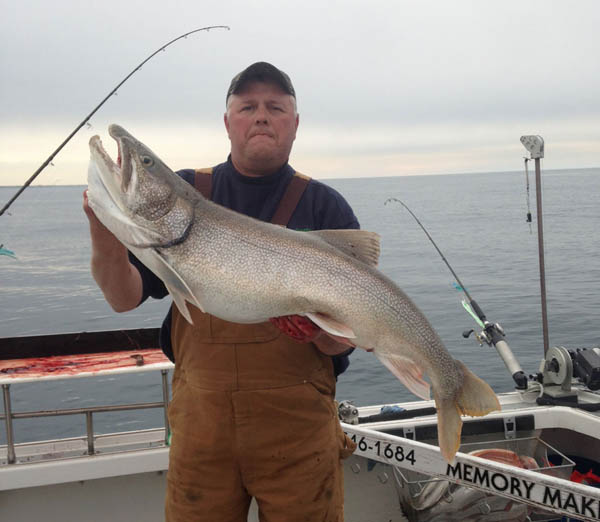FAQ'S
What will I need to bring on a Lake Michigan Fishing Charter?
Not as much as you might think as all fishing equipment is supplied. You will need a fishing license & salmon stamp (if you don't have a license we sell 2 day licenses on the boat), soft soled shoes (tennis, gym), adequate clothing for the day, camera, food, beverages, sunglasses, sun screen lotion and a cooler to take home the fish.
Click here to read more about what to bring on a Lake Michigan Charter Fishing Trip!
How Do I Make Reservations?
To experience the thrill of Lake Michigan Sport Fishing and make unforgettable memories, call us today at 847-746-1684.
What About Bad Weather?
In the event we determine the lake is too rough to fish, we will notify you ahead of time and re-schedule your date. However, there may be days when this decision is made at the dock and your deposit will be forwarded to another date. We do fish in inclement weather, so be prepared and bring your rain gear.
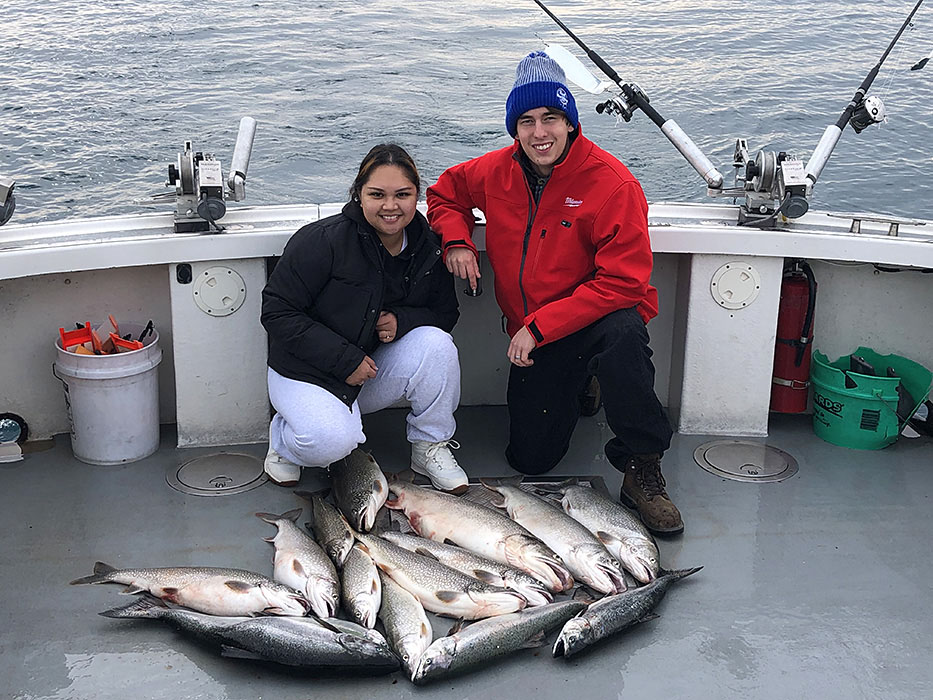
What Kind of Fish Will We Catch?
The size, species, and numbers of fish will depend on the time of the season you take your charter. Below are a list of species you might expect to catch during one of our charters:
What kind of boat will we be on?
Our boat, the Memory Maker, is a 2000 Donelle Sport Fishing Boat with a spacious deck, comfortable seating for all, plenty of fishing room, private washroom facility and comfortable heated wheelhouse.
Who will be our captain?
Our Captain is Captain Luke Stoyer. He has 8+ years of experience as a licensed USCG Captain charter fishing on Lake Michigan.
Where do we meet?
443 50th St.,
Kenosha, WI 53140
Dock Number: Slip 135
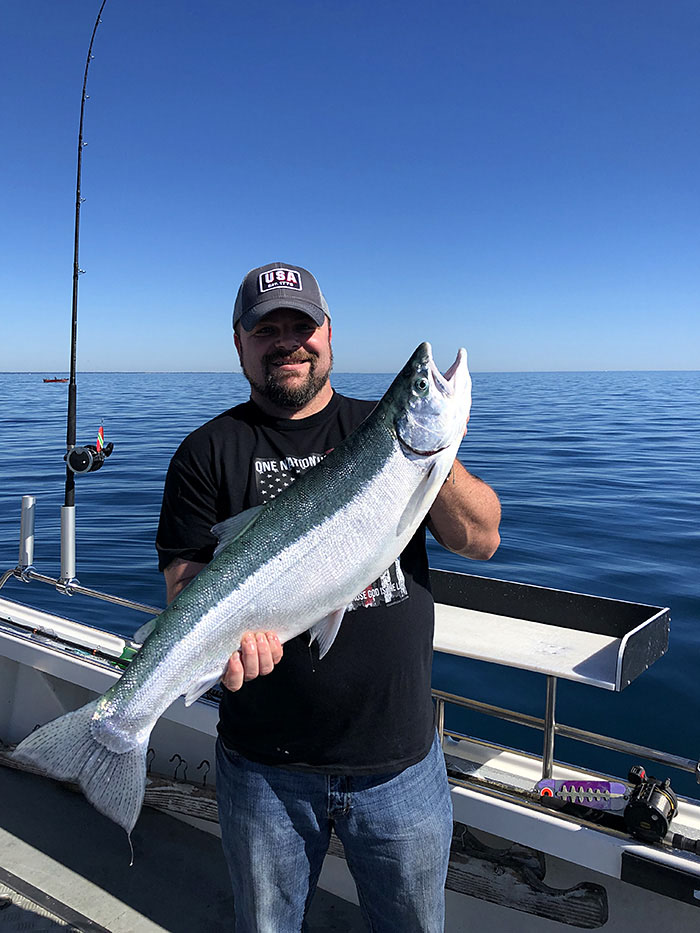
Is it kid friendly?
Of course, we are a family friendly fishing charter operation!
Do you offer multiple day packages?
Yes, we offer a number of different packages from 3-people up to 6-people from two 5-hour charters to two 8-hour charters, plus lodging and cleaning of your catch. We also offer 2 or 3 day charter fishing packages on Lake Michigan from Kenosha.
What fishing charter tips do you have before embarking?
You've booked your fishing charter, now what? Here are several suggestions to keep everyone's day stress free and allow for great memories to be made.
Coho Salmon
The Coho salmon, AKA: silver salmon, can be distinguished by the fine dark spots on the back and upper lobe of the tail fin, the long anal fin and gray gums!
Coho feed primarily on alewives, smelt, and other small fish. In Lake Michigan, cohos attain an average weight of 5 to 6 pounds before spawning at 3 years of age, but sometimes live as long as 4 years and weigh around 20 pounds.
Coho account for up to 75% of the salmon caught annually in the Illinois portion of Lake Michigan. Shoreline fishermen are generally successful fishing for this species using power lines, with pole and line baited with night crawlers, small alewives or strips of larger alewives and small spoons (cleo, wobbler, kastmaster). Coho prefer water temperatures between 52-59 degrees F., with the peak feeding temperature at 54 degrees F. Because these fish die after spawning an annual stocking program is conducted in the spring with the introduction of 5-6 inch fish. Another interesting point is that coho are generally found closer to the surface than the chinook although they prefer the same water temperature.
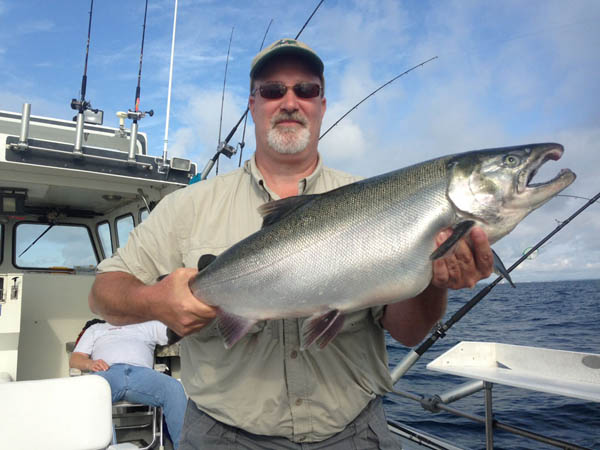
Chinook Salmon
Chinook salmon, AKA: king salmon can be distinguished by dark spotting on the back and usually on both lobes of the tail, a long anal fin and teeth set in black gums. They primarily feed on alewives and smelt. Their average life span is 4 years before they return to spawn and die.
Some may return earlier (having reached sexual maturity) between the ages of 2 of 4 and average between 2-15 pounds. Some live longer than 4 years and reach 40 pounds or more. Chinook tend to prefer the same temperatures as the Coho, but seem to be more light sensitive and harder to catch. The bank fishermen's catch of the Chinook is restricted to early fall, casting with plugs and spoons (cleo, wobbler, krocs and sometime flatfish).
The chinook run usually peaks before the coho run. The chinook population is maintained by annual stocking of 2-3 inch long fingerlings each spring.
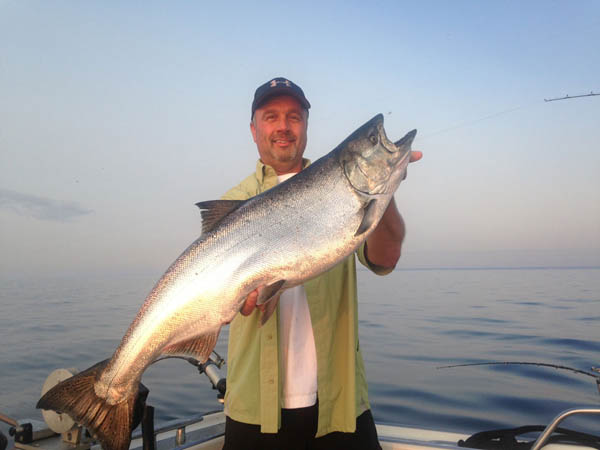
Rainbow Trout
The rainbow trout, AKA: steelhead trout is an attractive game fish that strike aggressively, fight valiantly and are an angler's joy. It is distinguished by its white mouth, black spots on the back and entire tail and its 12 or fewer anal fin rays. There is some confusion about the rainbow and steelhead, they are in fact the same species, differing only in spawning behavior. The rainbow spends its entire life in streams, whereas the steelhead is anadromous (lives in the ocean or large lake and returns to spawn). The average rainbow is about 5 pounds with some reaching 16 pounds by age 6. The record rainbow in Illinois weighed 31.7 pounds.
Rainbow trout feed on insects and fish. Rainbow prefer water temperatures of 55-60 degrees F. Bank fishermen catch rainbows in the spring, casting small lures or using bait such as small alewives, nightcrawlers and spawn sacs. Winter fishing for rainbow is good around the power plant warm water discharges and they are occasionally taken while ice fishing in harbor.

Brown Trout
Brown trout are distinguished by large black and sometimes reddish-orange spots with a pale border on the sides of the fish. These spots are modified Xs when the fish is large. They grow rapidly and may live to an age of 6 years and reach weights of 8 to 10 pounds. Some may reach 30 pounds in Lake Michigan.
They are among the wariest of fish, feeding usually at dusk or at night, so fishermen are the adult brown's chief predator. In many localities, surf casting for brown trout is popular. Brown trout prefer water temperatures between 55 degrees and 65 degrees F. and are typically found along the shoreline and at warm water discharges.
This wary fish can be taken more readily in early morning and twilight hours. Light line is in order using conventional lures or natural baits. Shore fishing methods are similar to the rainbow trout.
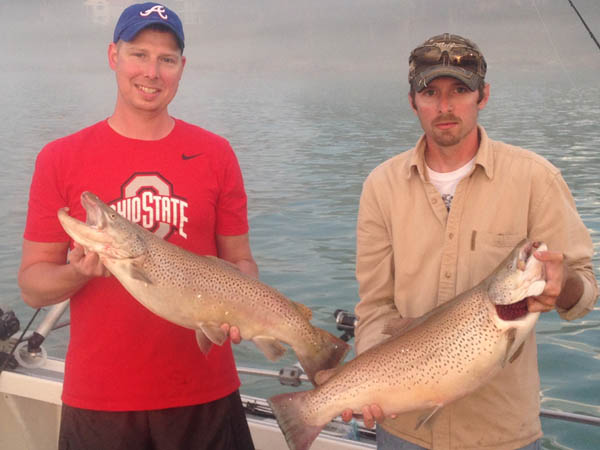
Lake Trout
Lake trout, AKA: laker, are long-lived and do not reach sexual maturity until 6-8 years of age. While the average lake trout in Lake Michigan today weighs around 7 pounds, some of the larger trophy fish are 3 feet long and weigh as much as 25 pounds.
Lake trout are usually found on the bottom between depths of 90 to 250 feet, but may be found at lesser depths when the water temperature is near 48 degrees F. Generally, lake trout are caught only from boats in Illinois. During the spring months, lake trout can be taken in the upper layers of warmer water, but as the season progresses and water temperatures go above 48 degrees F., lake trout are normally taken near the bottom. During the summer months (July-September) they tend to occur near the bottom where temperatures are between 45 and 50 degrees F. During the fall months mature lake trout move into shallow waters and reef areas in search of spawning areas. Shiny metal spoons are successful lake trout lures when fished properly. Lake trout feed on alewives, smelt, chubs and sculpins.
